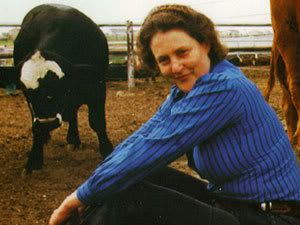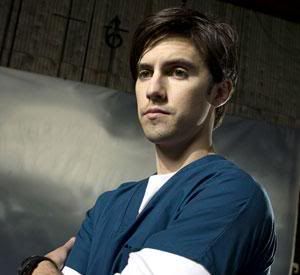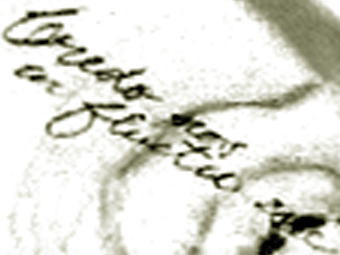I now believe I've worked out a possible pseudo-scientific account of how the aforementioned mental linkage and networking is accomplished. The keys are observation (purportedly Karen Degroot's pet value) and empathy (my own personal favorite).
An Anthropologist on Mars

I've been fascinated by the power of empathy ever since I read Oliver Sacks's collection of case studies An Anthropologist on Mars about people with autism and related disorders. The title is actually a self-description by Temple Grandin, a famous high-functioning autistic who teaches livestock behavior at Colorado State University.

By her own admission, Dr. Grandin lacks any instinctive ability to read the emotional states of people around her -- a feat most of us take for granted. She's had to learn to do so through careful study of rules (e.g., smile=happy) like an anthropologist might prepare for a close encounter with Martians whose nonverbal emotional cues differ from our own.
What's really interesting about Dr. Grandin is that, despite her difficulties empathizing with humans, she has no problem doing so with animals. In fact, she's devoted her career to designing more humane livestock holding and slaughter facilities. I remember a light bulb going off when I read that: feeling the pain of others is really the key to decency...usually.

Mirror, Mirror
It turns out that the neurological basis of empathy is a hot topic in scientific circles these days. Interest was first sparked by the discovery in monkey brains of specialized neurons devoted to imitation and mimicry. Subsequent research, including brain scans of people interacting with each other, suggests that we possess these so-called "mirror" neurons, too.
The apparent purpose of mirror neurons is to mimic the neurological states of those we observe. Writing before the explosion of research into these neurons, the noted neuroscientist V.S. Ramachandran described their discovery as "the single-most important 'unreported' (or at least unpublicized) stories of the decade." As Dr. Ramachandran explained:
With knowledge of these [mirror"> neurons, you have the basis for understanding a host of very enigmatic aspects of the human mind: "mind reading" empathy, imitation learning, and even the evolution of language. Anytime you watch someone else doing something (or even starting to do something), the corresponding mirror neuron might fire in your brain, thereby allowing you to "read" and understand another's intentions, and thus to develop a sophisticated "theory of other minds." (Full text here.)Scientists like Dr. Ramnachandran hypothesize that the loss of mirror neurons might explain autistic disorders, which are characterized by lack of empathy. And Pseudo-scientists claim such neurons could explain psychic powers. A character on the NBC show Heroes with the ability to mimic the powers of mutants around him is described as "hyper empathic."

Every Breath You Take...
All of which brings me back to the purpose of Pearl Station, which I'm assuming is the "?" on the Blast Door Map. The Pearl Orientation film informs viewers that the station's purpose is to monitor the psychological experiment in Swan. Yet the pile of unread logs strongly suggests this explanation was a ruse.

Other clues point to some other purpose. We know, for example, that Karen DeGroot preached: "Careful observation is the only key to true and complete awareness." And the Blast Door Map bears the mysterious Latin inscription "Credo nos in fluctu eodem esse," which translates to "I think we're on the same wavelength."

I believe the real function of Pearl was to facilitate mental linkage between its occupants and the Swan subjects. The hope was that careful observation would activate mirror neurons (i.e., empathy) coordinating the neurological states of those stations' occupants. Eventually, everyone in the network would get on the same mental "wavelength."
Pearl's central location suggests it was a nexus of some Island-wide network. The odd part is that Pearl's Orientation only mentions watching Swan, implying the link is just between those two stations. But Pearl is only 5 of 6, and the camera therein suggests some other station (and observers) could have completed the intermental network.
The Power of Empathy
In prior posts, I've cited the strange encounter between Kate and the unconscious Sawyer as the best illustration (besides the whispers) of mental linkage at work. Viewed through the lens of empathy and mirror neurons, the example makes even more sense. To review, Kate is nursing a feverish Sawyer in Swan while haunted by memories of Wayne.
All of Kate's attention and affection are focused on Sawyer, placing her mind on the same wavelength as his. She transmits dark thoughts of daddy to Sawyer, who transmits back a kiss, which is how he'd comfort her if conscious. But because they don't realize what's happening, their minds get crossed like the Flash and Green Lantern in Walt's comic.
As a result, Sawyer starts talking like Wayne and Kate plants a wet one on Jack (also an object of Kate's affection) who then runs off to chop wood like Sawyer. As Hurley says to Jack shortly thereafter: "It's like, transference."

Another example of this effect is the unusually strong connection between Rose and Bernard. Recall that she was sure Bernard had survived the crash -- the result of her receiving signals from his mind? A similar dynamic might even explain the significance of Desmond and Penelope's relationship -- their thoughts are on the same wavelength.
That latter possibility of long distance transmission and reception off the Island raises intriguing possibilities. The premise of my theory 108: Restoring the Lost Sun was that the Island's non-metallic minerals (e.g., quartz?) made it a kind of natural transceiver. Maybe Dharma's ultimate goal was a worldwide intermental network.
I'll explore such a scenario further in a revised version of that theory. The relevant question here is why Dharma failed. If the Island is still so successful at linking minds, why do the Numbers remain unchanged? What could possibly have gone wrong? The "sickness" (which I believe refers to this linking effect) is a big clue.

Neither orientation film mentions the quarantine or vaccine because they came after Dharma's official end. My suspicion is that the Initiative worked all too well. The Island not only linked the original participants' minds, it actually created an emergent species capable of transitioning between individual and collective consciousness at will.
The problem is that members of this newly evolved species have lost much of their empathy for humanity at large. For some reason, they view the majority of their former species as "bad people." And while it's still not entirely clear whether that's a reference to character or some other trait, the connotation of inferiority is unmistakable.
If that seems farfetched, think back to the example of Dr. Grandin. Her ability to empathize across species is exceptional and rare. Most people view other species the way she does "neurotypical" individuals -- with empathy that is learned. Against that backdrop, Tom's comment about Kate not being "his type" takes on a whole new meaning...


0 comments:
Post a Comment